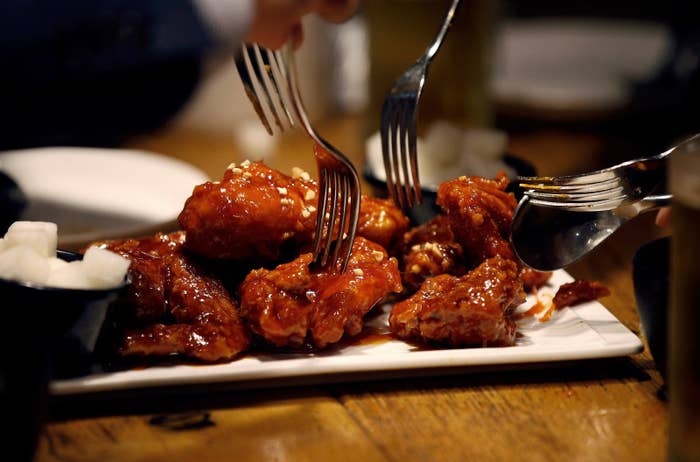
If you want to marvel at how humans can mess with nature, look no further than the modern chicken.
Over decades of work, the poultry industry has created a chicken that grows bigger and faster with less feed. A factory chicken today takes just 47 days to grow to an average weight of about 6.24 pounds. In 1965, they took 63 days to grow to just 3.48 pounds.
These birds provide the world with a cheap and almost universally available source of protein. But those ultra-fast-growing chickens are designed to suffer, activists say: the rate at which they pack on pounds causes health issues like skeletal defects and heart failure, in addition to being linked to problems such as white striping and woody breast that affect the quality of their meat.
Even if farmers improve the environment that chickens live in, their misery is rooted in their DNA, many insist. "Factory farming is a cheap way to produce a lot of chicken, but it has gone too far," according to the animal rights group Compassion in World Farming.
While people have manipulated chicken genetics for a millennia through selective breeding, modern corporations have supercharged the process. Almost all of the so-called factory chicken we eat today comes from a small number of breeds designed by genetics companies — and the names of the breeds reflect that. Forget about Rhode Island Reds or Leghorns: Today, your tenders are more likely to come from a Ross 708 (a "high meat yielding bird") or the Hubbard M99.

But as their customers become more aware and interested in the origins of their meals, food businesses have begun committing to purchasing slower-growing chickens, once enough become available at the scale needed to supply giant chains. Some, including Panera, Whole Foods, Chipotle, Noodles & Co, have partnered with animal welfare groups like CIWF and the Humane Society and committed to changing over to new breeds by 2024.
On Feb. 14, Wendy's committed to use chickens that are 20% smaller, a change the company said is mainly to improve taste, although it also "expects to see benefits to the welfare of chickens." Perdue, one of the world's largest poultry producers, has pledged to free its chickens "from pain, injury and disease," and said it has been "exploring various ways to slow growth of existing breeds as well as utilizing heritage breeds to determine ways that have a meaningful, positive impact on the wellbeing of our chickens."
All this effectively means backing away from decades of breeding research and returning to a chicken that — at least by productivity metrics — is an inferior breed. The slower-growing chickens being considered by some poultry producers gain an average 50 grams of weight per day, compared to current industry average of 61 grams.
The National Chicken Council, the industry's main lobbying group, is not convinced that such a switch would improve animal welfare, but says it "supports further research on the topic of chicken welfare and growth rates.”
"The more you are around chickens, the more you ‘know’ what they want, but we are looking for more objective ways to measure it," said Perdue senior vice president Bruce Stewart-Brown. Perdue is looking at changes — both genetic and environmental — that allow the birds "to do the things that chickens want to do, which is act like chickens."
Some of that research starts with the three breeding companies that fuel the poultry industry: Cobb-Vantress (a subsidiary of Tyson), Aviagen, and Hubbard (which is owned by the French company Groupe Grimaud).
Each has slow-growing breeds, but Hubbard says it dominates the slow-growing chicken market, which is bigger in Europe. Varieties include Label Rouge and the Chicken of Tomorrow. "We're ahead of the game with these genetics," said Sean Holcombe, Hubbard's director of sales and technical Services for the US and Canada.
Any shift by the industry wouldn't be as simple as switching out the birds. "They're a different chicken, they act differently," said Perdue's Stewart-Brown. To start, chickens that put on weight slower tend to be more active. During research, "They were all out of the pens; they had messed up the groupings. We had to redesign the chicken house."
Then there's the cost difference. Chicken producers analyze and manage their costs down to hundredths of a cent for conventional birds, but today's slower-growing breeds require more feed and, obviously, require more time to reach market weight. According to Whole Foods, which already sells some slower-growing chicken, it also means consumers get a smaller chicken breast, and it will have a different flavor profile. If this is what consumers demand, "consumers will have to pony up and pay extra for their food," said Holcombe. As chicken farmers won't be as productive, they "will have to be compensated for the difference."
Consumers may also notice a difference in texture. "We all grew up on soft, squishy chicken," Holcombe said, and the smaller birds are "a bit more chewy."
